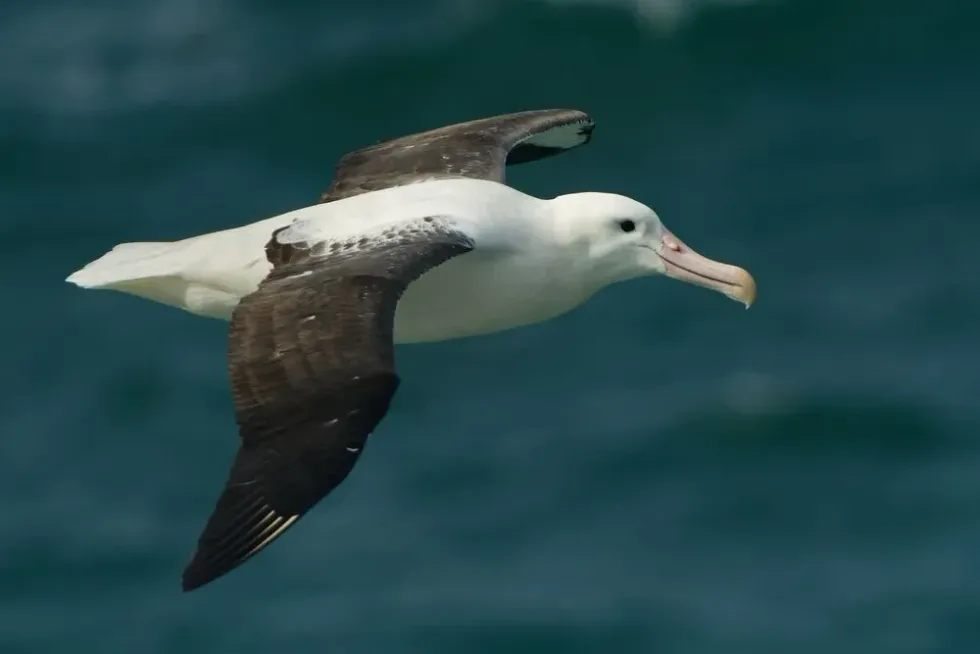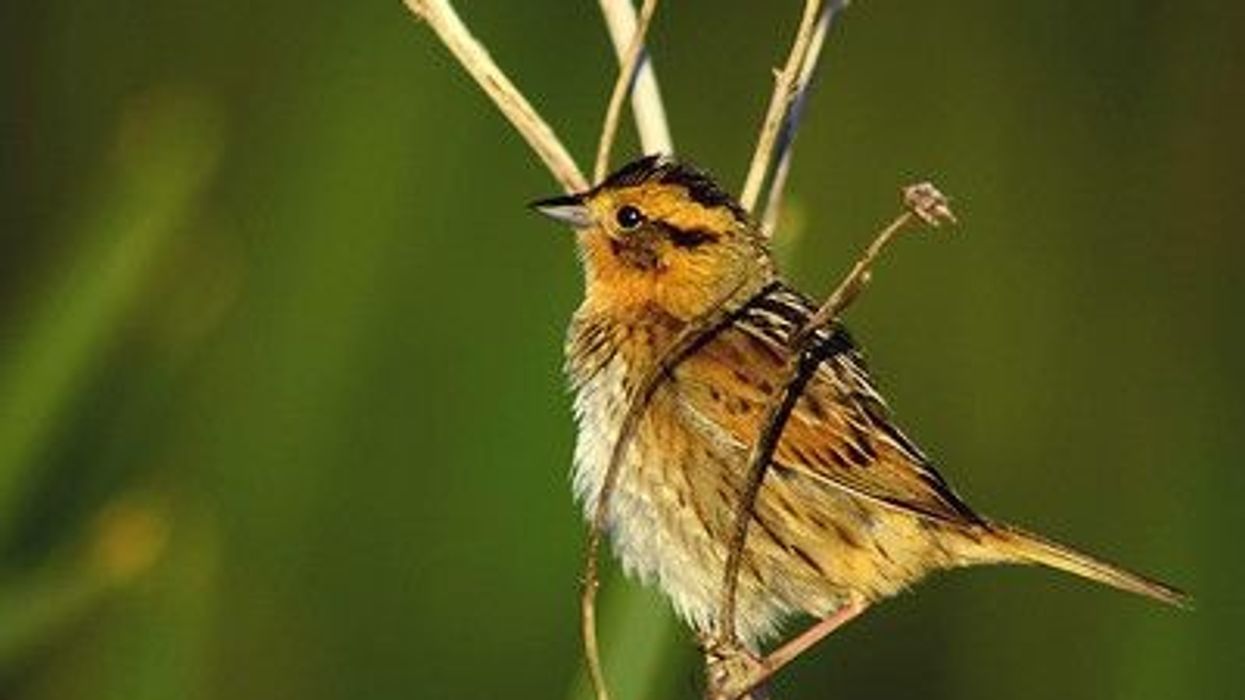The northern royal albatross is a bird species found in the Southern Hemisphere. It is a mostly white bird with black upper wings and a pale pink bill.
This albatross is called toroa in the Maori language. This bird is known to breed mostly in the country of New Zealand on the Chatham Islands. Apart from that, it is seen in southern South America and flying over the waters of the Southern Ocean.
When not living near the ocean waters, the northern royal albatross likes inhabiting windy slopes that have ample tussock grass, as well as open areas. Northern royal albatrosses reproduce every alternate year by laying a singular egg.
They usually live alone or with mates in breeding colonies. They form monogamous bonds and are known to perform mating displays like wing-clapping and groaning. Both parents share the nesting and parental duties.
Northern royal albatrosses live for 58-80 years. According to the Red List of the IUCN, the northern royal albatross species has an Endangered conservation status.
For more relatable content, check out these swallow-tailed kite fun facts and blackpoll warbler interesting facts pages.
Northern Royal Albatross Interesting Facts
What type of animal is a northern royal albatross?
The northern royal albatross (Diomedea sanfordi) is a bird.
What class of animal does a northern royal albatross belong to?
The northern royal albatross (Diomedea sanfordi) belongs to the Aves class of animals.
How many northern royal albatrosses are there in the world?
As of 2016, there were 17,000 mature birds of the northern royal albatross (or toroa) species in the world. The royal albatross has a larger population than northern royal albatross.
Where does a northern royal albatross live?
Northern royal albatrosses (or toroa) breed in New Zealand in the Otago Peninsula on the South Island, as well as in the Chatham Islands. In the Chatham Islands, they breed in the Forty-fours group of islands and on the Little and Big Sister Islands.
The Auckland Islands, Enderby Island and the Otago Peninsula's Taiaroa Head are known to see breeding northern royal albatross birds.
When they are not breeding in New Zealand, the northern royal albatross range extends to the coasts of the southern parts of South America on either side. They are mostly seen over the Chilean slope and the continental shelf and Argentina's Patagonian shelf. In winter, these birds occasionally occupy Tasmania and South Africa.
What is a northern royal albatross's habitat?
For the breeding season, northern royal albatross birds prefer a habitat with windy slopes that have plenty of tussock grass. The tussock grass provides them with a better shelter. They are also known to nest and breed in more open areas so that they can take off and land with ease.
Outside of the breeding season, northern royal albatross birds are mostly found at sea.
Who do northern royal albatrosses live with?
Northern royal albatrosses (or toroa) usually feed alone, but many birds are known to gather near abundant food sources. They are also seen with their mates in the breeding colonies.
How long does a northern royal albatross live?
Northern royal albatrosses are known to reach ages of 58-80 years.
How do they reproduce?
Northern royal albatrosses reproduce by mating and laying eggs. The male northern royal albatross is the first to arrive at the breeding colony habitat. When the female and male albatross birds meet, they greet each other with displays like the clapping of wings, groans, and holding their heads high.
Northern royal albatross birds tend to be monogamous and build long-term bonds with its mate. The nesting duties are shared by both adults. The same nesting site is used time and time again.
Northern royal albatrosses breed every alternate year because of the long breeding cycle. The breeding season is usually in October and November. Sexual maturity is attained at the age of eight to nine.
The nest is usually built on the ground, with mud and grasses that form a shallow depression. One white egg is laid by the female. The egg is incubated by both sexes for 77-79 days. They usually exchange incubation duties every eight days.
The chicks take three to six days to emerge from the egg at the end of incubation. Both parents take turns providing food and guarding the chicks for the initial five to six weeks. Fledging takes place when the chicks are eight months old.
Post-breeding, the adults live at sea for a year before returning to the same breeding range colony to initiate a new cycle. If the birds fail to breed, they renest for consecutive years until they find success. The young fledged albatross chicks spend several years in the South American waters, away from New Zealand.
What is their conservation status?
The conservation status of the northern royal albatross (Diomedea sanfordi) species according to the International Union for Conservation of Nature is Least Concern.
Northern Royal Albatross Fun Facts
What do northern royal albatrosses look like?
The adult northern royal albatross bird has mostly white plumage, the upperparts included. The upper wing tends to be black, and the underwing is white apart from the leading edge from the wingtip to the carpal joint which is black.
The tail is also white but may sometimes have black tips. The head of the northern royal albatross is white, although some of the females tend to have a crown that is speckled black.
The bill is hooked and pale pink in color. The upper mandible of the bill has a darker cutting edge. The eyes of the northern royal albatross are dark brown.
The webbed feet and legs are either pale pink or flesh-colored. In the breeding season, the tarsi and the bill have a darker pink shade. The adult male northern royal albatross is slightly bigger than the female.
The juvenile albatross is mostly white and has black speckles on the rump and the lower back. The upper wing of the juvenile is a blackish-brown color, and there are some white markings on the wing-coverts. The white tail of the juvenile sometimes has dark tips. The crown also has some dark speckles sometimes.

How cute are they?
Northern royal albatrosses are beautiful and ceremonious creatures. They are one of the most gorgeous white birds that adorn the Southern Ocean. Their soaring and dynamic flights are a sight to see because of their narrow and expansive wingspans.
How do they communicate?
Northern royal albatrosses communicate via calls and displays. They are mostly silent when at sea, but they make gurgling and croaking sounds when they are feeding close to fishing boats. They also perform courtship displays that are accompanied by grunts, groans, throaty cries, and moans. A rattling sound made by the clappering of bills is also seen.
How big is a northern royal albatross?
Northern royal albatrosses are 45.3 in (115 cm) long, which makes them 10-13 times bigger than verdins. Also, the northern royal albatross wingspan is 106.3-120.1 in (270-305 cm).
How fast can a northern royal albatross fly?
Northern royal albatrosses can fly up to speeds of 70 mph (112.7 kph).
How much does a northern royal albatross weigh?
A northern royal albatross weighs 13.7-18.1 lb (6.2-8.2 kg).
What are the male and female names of the species?
Male and female northern royal albatrosses do not have specific names, but like all birds, they may be called cock and hen respectively.
What would you call a baby northern royal albatross?
A baby northern royal albatross is called a chick.
What do they eat?
Northern royal albatrosses eat squid, fish, crustaceans, cephalopods, carrion, and salps. They do not have natural predators, but the small chicks and eggs get preyed on by ferrets and cats.
Are they dangerous?
No, northern royal albatrosses are not dangerous.
Would they make a good pet?
Northern royal albatrosses are wild birds and they are endangered. They cannot be taken as pets and they should not be kept in captivity either.
Did you know...
The cool thing about the northern royal albatross was that it was considered conspecific with the southern royal albatross (Diomedea epomophora) until 1998.
Why is the northern royal albatross endangered?
Northern royal albatrosses are presently endangered. Extreme weather events in the past have impacted their populations.
A cyclonic storm hit their breeding sites on New Zealand's Chatham Islands in 1985. This storm reduced the cover of soil and damaged most of the vegetation.
Trawling and longline fishing in the Southern Ocean have also increased their mortality rate. However, in the colony of Taiaroa Head, juveniles and adults seem to survive fishing-related activities better.
There is not much data about the mortality of northern royal albatrosses on the Chatham Islands, but there possibly is a significant amount of harvesting done by the locals there. There may also be predation of chicks and eggs by ferrets and rats that has resulted in a population decline.
Are northern royal albatrosses migratory?
Yes, northern royal albatross migration sees them go away from New Zealand to southern South America, on either side in places like Chile, Argentina, South Africa, and Tasmania.
Here at Kidadl, we have carefully created lots of interesting family-friendly animal facts for everyone to discover! Learn more about some other birds from our northern gannet interesting facts, and the common swift surprising facts pages.
You can occupy yourself at home by coloring in one of our free printable white-capped albatross coloring pages.









